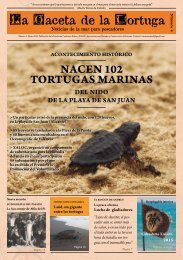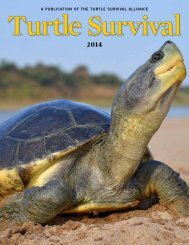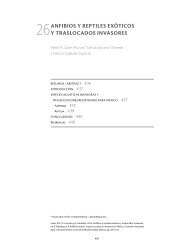tsrp63entire
tsrp63entire
tsrp63entire
Create successful ePaper yourself
Turn your PDF publications into a flip-book with our unique Google optimized e-Paper software.
Bradfield, K.S. 2004: Photographic identification of individual Archey’s frogs, Leiopelma archeyi, from natural markings.<br />
DOC Science Internal Series 19. Department of Conservation, Wellington. 36 p.<br />
Brown, D. 1994: Transfer of Hamilton’s frog, Leiopelma hamiltoni, to a newly created habitat on Stephens Island,<br />
New Zealand. New Zealand Journal of Zoology 21: 425–430.<br />
Brown, D. 2000: Stephens Island: Ark of the Light. Cloudy Bay Publishing, Blenheim. 248 p.<br />
Brown, D.; Tocher, M.D. 2003: Potential sites for the translocation of Archey’s frog. Waikato Conservancy, Department of<br />
Conservation, Hamilton (unpublished).<br />
Clemas, R.J.; Germano, J.M.; Speare, R.; Bishop, P.J. 2009: Evaluating alphanumeric tags for use in Australian frogs<br />
(genus: Litoria) with notes on the placements of tags in relation to subcutaneous lymph sacs. New Zealand<br />
Natural Sciences 34: 1–7<br />
Cree, A. 1985: Water balance of New Zealand’s native frogs. Pp. 361–371 in Grigg, G.; Shine, R.; Ehmann, H. (Eds):<br />
Biology of Australasian frogs and reptiles. Surrey Beatty, Chipping Norton, New South Wales.<br />
Crossland, M. 2006: Review of evidence for negative impacts of poison-based mammalian pest control operations on<br />
native frog populations. Waikato Conservancy, Department of Conservation, Hamilton (unpublished). 12 p.<br />
Crossland, M.R.; MacKenzie, D.I.; Holzapfel, S. 2005: Assessment of site-occupancy modeling as a technique to monitor<br />
Hochstetter’s frog (Leiopelma hochstetteri) populations. DOC Research and Development Series 218. Department<br />
of Conservation, Wellington. 23 p.<br />
Daglish, L.A. 2010: MAO 2009–2010 frog monitoring report. Maniapoto Area, Waikato Conservancy, Department of<br />
Conservation, Te Kuiti (unpublished). 4 p.<br />
Daszak, P.; Berger, L.; Cunningham, A.A.; Hyatt, A.D.; Green, D.E.; Speare, R. 1999: Emerging infectious diseases and<br />
amphibian population declines. Emerging Infectious Diseases 5(6): 735–748.<br />
DOC (Department of Conservation) 2008: Recovery Planning Standard Operating Procedure for threatened species:<br />
resource kit. Internal report (QD code 1043/03). Department of Conservation, Wellington (unpublished). 54 p.<br />
DOC (Department of Conservation) 2009: Atlas of the amphibians and reptiles of New Zealand. Department of<br />
Conservation, Wellington. 122 p.<br />
DOC (Department of Conservation) 2013: Statement of Intent 2013–2017. Department of Conservation, Wellington. 53 p.<br />
DOC (Department of Conservation); MfE (Ministry for the Environment) 2000: The New Zealand Biodiversity Strategy:<br />
our chance to turn the tide. Department of Conservation and Ministry for the Environment, Wellington. 144 p.<br />
Eggers, K.E. 1998: Morphology, ecology and development of leiopelmatid frogs (Leiopelma spp.), in Whareorino Forest,<br />
New Zealand. Unpublished MSc thesis, Massey University, Palmerston North. 169 p.<br />
Fouquet, A.; Ficetola, G.F.; Haigh, A.; Gemmell, N. 2010a: Using ecological niche modelling to infer past, present<br />
and future environmental suitability for Leiopelma hochstetteri, an endangered New Zealand native frog.<br />
Biological Conservation 143(6): 1375–1384.<br />
Fouquet, A.; Green, D.M.; Waldman, B.; Bowsher, J.H.; McBride, K.P.; Gemmell, N.J. 2010b: Phylogeography of Leiopelma<br />
hochstetteri reveals strong genetic structure and suggests new conservation priorities. Conservation Genetics 11:<br />
907–919.<br />
Gemmell, N.J.; Bowsher, J.H.; Gomas, K.P. 2003: Genetic affinities of Hochstetter’s frog (Leiopelma hochstetteri)<br />
populations in the Bay of Plenty. DOC Science Internal Series 141. Department of Conservation, Wellington. 19 p.<br />
Germano, J.M.; Bishop, P.J. 2008: Suitability of amphibians and reptiles for translocation. Conservation Biology 23(1): 7–15.<br />
Germano, J.M.; Molinia, F.C.; Bishop, P.J.; Bell, B.D.; Cree, A. 2012: Urinary hormone metabolites identify sex and<br />
imply unexpected winter breeding in an endangered, subterranean-nesting frog. General and Comparative<br />
Endocrinology, 175: 464–472.<br />
Gleeson, D.; Clay, C.; Gemmell, N.; Howitt, R.; Haigh, A. 2010: Summary report: Leiopelma hochstetteri population genetic<br />
structure. Landcare Research contract report LC 077 for the Department of Conservation (unpublished). 18 p.<br />
Green, D.G.; Tessier, C. 1990: Distribution and abundance of Hochstetter’s frog, Leiopelma hochstetteri. Journal of the<br />
Royal Society 20(4): 261–268.<br />
Haigh, A.; Pledger, S.; Holzapfel, S. 2007: Population monitoring programme for Archey’s frog (Leiopelma archeyi):<br />
pilot studies, monitoring design and data analysis. DOC Research & Development Series 278. Department of<br />
Conservation, Wellington. 25 p.<br />
Holyoake, A.; Waldman, B.; Gemmell, N.J. 2001: Determining the species status of one of the world’s rarest frogs: a<br />
conservation dilemma. Animal Conservation 4: 29–35.<br />
34 Bishop et al.—Native frog recovery plan, 2013–2018





